
Asia is home to some of the world’s richest countries by GDP per capita in purchasing power parity (PPP). These economies range from global financial powerhouses like Singapore to resource-rich countries such as Qatar and the United Arab Emirates. Despite the variety in size and population, these Asian countries share commonalities in strategic economic planning, technological innovation, and robust trade practices that have catapulted them onto the global stage as financial leaders.
Here’s a look at the ten richest countries in Asia in 2025, based on GDP per person using purchasing power (PPP). These countries stand out because they focus on areas like finance, technology, and petrochemicals. They also have strong infrastructure and innovative government policies that support long-term growth and a high quality of life.
10 Richest Countries In Asia
Rank Country GDP/Capita (PPP)
1 Singapore $156,755.35
2 Qatar $121,605.13
3 Brunei Darussalam $95,758.15
4 United Arab Emirates $81,675.95
5 Bahrain $67,794.56
6 South Korea $65,111.9
7 Cyprus $65,088.33
8 Saudi Arabia $61,922.82
9 Israel $56,435.71
10 Japan $54,677.12
1. Singapore – $156,755 GDP/Capita (PPP)
Singapore has the second-highest GDP per person in the world (based on PPP), thanks to its strong role as a global center for finance, trade, and technology. Even though it doesn’t have many natural resources, Singapore has used its location wisely to become a significant port and trading hub. It focuses on refining and improving imported goods before exporting them again.
The country is known for its open economy, easy-to-do-business rules, low levels of corruption, and welcoming environment for investors. These strengths attract large amounts of foreign investment from international companies and financial institutions.
Singapore’s primary industries include electronics, medicine, biotechnology, finance, oil refining, marine engineering, and tourism. It is also a top place for wealth management and is known as Asia’s financial center.
Because land is limited, Singapore uses bright ideas like vertical farming and agrotechnology parks to grow food and stay secure. The country’s fast growth into a rich, developed nation, especially under Prime Minister Lee Kuan Yew, is often called an economic “miracle,” making it one of the wealthiest countries in the world.
2. Qatar – $121,605 GDP/Capita (PPP)
Qatar is one of the wealthiest countries in Asia, thanks to its huge natural gas and oil reserves. It has the third-largest proven gas reserves in the world. Oil and gas make up more than 60% of its economy, over 70% of government income, and about 85% of its exports.
To prepare for the future, Qatar is using its energy wealth to invest in other areas of the economy. Through its Qatar National Vision 2030 plan, the country is working to grow beyond oil and gas and build a more balanced economy.
Qatar’s economy stayed strong even during regional sanctions, mainly because of its strong trade ties with big Asian countries like Japan, South Korea, India, and China. The government plans to boost its natural gas output through QatarEnergy’s North Field expansion projects, helping it stay the world’s top exporter of LNG (liquefied natural gas).
Qatar is also working to grow other industries like petrochemicals, fertilizers, and steel, with support from major industrial areas in Ras Laffan and Mesaieed. Even with challenges like changing oil prices, Qatar remains one of Asia’s richest countries thanks to smart economic planning and investments from its large national wealth fund.
3. Brunei – $95,758 GDP/Capita (PPP)
Brunei is one of the richest countries in Asia because it makes a lot of money from selling oil and natural gas. These two resources are the biggest part of Brunei’s economy. They make up more than half of the country’s total income and most of what Brunei sells to other countries.
Brunei has a small population, so the money it earns is shared among fewer people. This gives it a high income per person, ranking third in Asia when adjusted for cost of living (PPP). The country also has a lot of savings, managed by the Brunei Investment Agency, which helps keep the economy strong even when oil prices go up or down.
Brunei has been trying to grow its economy in other areas besides oil and gas, like farming, fishing, making halal products, and petrochemicals. The government encourages businesses from other countries to invest by offering benefits like not having to pay taxes for a while. But even with these efforts, Brunei still depends a lot on oil and gas, and its economy can go up and down with oil prices.
The Brunei government gives strong support to its people. It helps pay for healthcare, housing, and food, which helps keep the country peaceful and stable.
4. United Arab Emirates – $81,675 GDP/Capita (PPP)
The United Arab Emirates (UAE) is one of the richest countries in Asia, mainly because of its large oil and gas resources, especially in Abu Dhabi. In the past, the country depended mostly on money from oil. But over time, the UAE—especially Dubai—has worked hard to grow other parts of its economy.
Dubai has focused on things like tourism, banking, real estate, and transport. Because of this, it has become a major global business center. It’s home to famous places like the Dubai International Financial Centre, the Burj Khalifa (the world’s tallest building), and the Palm Islands.
The UAE has one of the most open and welcoming economies in the region. It has modern roads, buildings, and services, and it’s a great place to do business. Even though the country is working to grow other parts of its economy, selling oil still brings in a lot of money for the government.
The COVID-19 pandemic caused some problems for the economy, but the UAE made changes to become stronger and more prepared for the future. Lately, the country has been investing more in clean energy, like solar and nuclear power. Big projects include Masdar City (a green city) and the Barakah nuclear power plant.
5. Bahrain – $67,794 GDP/Capita (PPP)
Bahrain is one of the richest countries in Asia when looking at income per person. Most of its money comes from oil and natural gas, which help pay for government services and are big export products. But Bahrain doesn’t have as much oil as some of its neighbors, so it has worked hard to grow other parts of its economy.
The country has focused on banking, finance, and tourism. Its capital city, Manama, has become an important center for global finance, especially in Islamic banking, and is home to many international banks.
Bahrain’s government supports a free and open economy. It was the first country in the Gulf to sign a free trade deal with the United States. Even though changing oil prices can cause problems, Bahrain keeps its economy strong by investing in important areas like roads, buildings, aluminum factories, chemicals, and ship repair.
The country also welcomes businesses from other countries and allows full foreign ownership in many sectors to attract more investment.
6. South Korea – $65,111 GDP/Capita (PPP)
South Korea has one of the most developed and successful economies in Asia. It ranks 26th in the world for income per person (measured by PPP) at about $65,000. After being badly affected by war in the 1950s, South Korea made a huge comeback and became a rich country in just a few decades. This fast growth is often called the “Miracle on the Han River.”
The country focused on building its economy through technology, factories, and selling products to other countries. Today, South Korea is a world leader in electronics, shipbuilding, car-making, telecommunications, and steel. Big companies like Samsung, Hyundai, LG, and SK helped make this success possible.
South Korea’s strong economy is supported by big investments in research and new technology—almost 5% of the country’s total income is spent on this, which is one of the highest in the world. The country also has a very well-educated population and modern infrastructure like fast internet and good transportation.
However, South Korea faces some problems. The population is getting older quickly, fewer babies are being born, many young people have trouble finding jobs, and there’s still a big gap between rich and poor.
7. Cyprus – $65,088 GDP/Capita (PPP)
Cyprus is a rich and developed country, according to the World Bank and IMF. Its economy changed a lot after it started using the Euro in 2008. In 2013, Cyprus had a big money problem and needed a €10 billion loan to help fix it. The government also took some money from people’s bank accounts without insurance, which was very unpopular. This caused the economy to shrink until 2015.
After that, Cyprus started to recover steadily. Today, its economy mainly depends on services like tourism, business support, and light manufacturing.
Most of Cyprus’s economy comes from services like tourism and business, which make up about 85.5% of its total income. The rest comes from industries and farming. Cyprus has a very high quality of life, and as of February 2025, not many people are unemployed—only about 4.9%.
Cyprus also trades a lot with other countries, especially with countries in the European Union.
8. Saudi Arabia – $61,922 GDP/Capita (PPP)
Saudi Arabia has some of the biggest oil reserves in the world—the second largest. This oil has made the country very rich and important globally. Oil makes up about 30% of the country’s total income, more than half of what the government earns, and most of what Saudi Arabia sells to other countries.
Saudi Aramco, the government-owned company, is the biggest oil exporter in the world and takes care of these oil resources.
Saudi Arabia knows relying only on oil can be risky, so it started a big plan called Vision 2030 to grow other parts of its economy. The country is working on industries like making chemicals, manufacturing, and mining. It’s also investing in building better roads, boosting tourism, and developing new technologies.
To bring in more money from other countries, Saudi Arabia has made trade rules easier and now allows foreign companies to own businesses in some industries entirely.
9. Israel – $56,435 GDP/Capita (PPP)
Israel’s economy is very active and open, with lots of new ideas and strong support for new businesses. Each person in Israel earns about $56,435 on average. The country has quickly changed from farming to becoming a world leader in technology and innovation.
Israel has the second-most startup companies in the world, after the U.S., and many big companies like Intel, Microsoft, and Google have important research centers there.
Even though Israel doesn’t have many natural resources, it has used its smart and well-educated people and a strong culture of starting new businesses to build strong industries.
These include technology, medicine, defence, and diamond cutting. Its high-tech area, called “Silicon Wadi,” is very important for the economy.
Also, Israel recently found natural gas under the sea, which will help the country have more of its energy.
Israel faces some economic problems, like a big gap between rich and poor, and about 20% of people live in poverty. There are also challenges because some groups, like the ultra-Orthodox community, are growing fast, but many don’t work.
In addition, political tensions and recent conflicts have hurt the economy. This has caused experts to lower their predictions for growth and made it harder for Israel to borrow money.
10. Japan – $54,677 GDP/Capita (PPP)
Japan has the fourth biggest economy in the world, worth about $4.19 trillion in 2025. The country is famous for its strong industries and new ideas, especially in making cars, electronics, robots, and other advanced technology. Toyota, a Japanese company, is the biggest carmaker in the world.
Even though Japan doesn’t have many natural resources, it is very powerful in the global economy because it lends a lot of money to other countries and has saved more than $1.2 trillion. The Tokyo Stock Exchange is the second biggest in Asia and the third biggest in the world for the value of companies listed there.
After World War II, Japan grew very quickly and became the world’s second-biggest economy by 1968. It also made a lot more money from selling goods to other countries than it spent buying them.
But in the 1990s, Japan’s economy hit big problems after a real estate and stock market crash. This led to many years of slow growth and falling prices, called the “Lost Decades.”
Today, Japan has some significant challenges, like very high government debt—about 2.6 times its total economy—and a population that is getting smaller and older.
Conclusion:
Asia has some of the richest and fastest-growing countries in the world. These countries are strong in areas like technology, manufacturing, finance and natural resources, which helps their economies proliferate.
Their increasing wealth helps develop the region and also affects the world’s economy. Knowing about these top countries helps us find new opportunities and shows how Asia is becoming more critical in the world.
FAQs
Q1: How is a country’s wealth measured?
A: Wealth is often measured by Gross Domestic Product (GDP), which is the total value of goods and services a country produces.
Q2: Are the richest countries in Asia also the most developed?
A: Many of them are highly developed with advanced industries, but some fast-growing countries are still developing.





